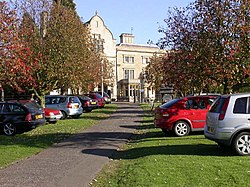Knuston Hall: Difference between revisions
mNo edit summary |
m clean up, typos fixed: extentions → extensions |
||
| Line 24: | Line 24: | ||
By 1834, after having passed through a number of hands, Knuston Hall lay empty, but in 1849 it was leased from its owner, Alan Gulston, by Edward John Sartoris for £160 a year until 1852. Sartoris's brother lived nearby at [[Rushden Hall]]: his wife was Adelaide Kemble, an opera singer and her sister, Fanny Kemble, a much fêted actress. | By 1834, after having passed through a number of hands, Knuston Hall lay empty, but in 1849 it was leased from its owner, Alan Gulston, by Edward John Sartoris for £160 a year until 1852. Sartoris's brother lived nearby at [[Rushden Hall]]: his wife was Adelaide Kemble, an opera singer and her sister, Fanny Kemble, a much fêted actress. | ||
In 1865 the Knuston Hall estate was bought by Robert Arkwright, great-grandson of Sir Richard Arkwright, inventor of the Spinning Frame. Arkwright made major | In 1865 the Knuston Hall estate was bought by Robert Arkwright, great-grandson of Sir Richard Arkwright, inventor of the Spinning Frame. Arkwright made major extensions to the house: the entrance hall, main staircase and several bedrooms are from this time, as are the ground floor's stone corridor and the matching corridor above. Arkwright lived at Knuston Hall until his death in 1888, after which the house was inherited through his family, though it was frequently let out. | ||
The author H E Bates was born in Rushden in 1905. His novel "Spella Ho", first published in 1938, is based around "a country mansion" called Spella Ho which is modelled on Knuston Hall during the period when it was owned by The Arkwrights. | The author H E Bates was born in Rushden in 1905. His novel "Spella Ho", first published in 1938, is based around "a country mansion" called Spella Ho which is modelled on Knuston Hall during the period when it was owned by The Arkwrights. | ||
Revision as of 17:57, 30 January 2016
| Knuston Hall | |
| Northamptonshire | |
|---|---|
 Knuston Hall | |
| Location | |
| Grid reference: | SP93836610 |
| History | |
| Built 17th to 19th centuries | |
| Country house | |
| Information | |
| Owned by: | Northamptonshire County Council |
| Website: | knustonhall.org.uk |
Knuston Hall stands near Rushden in Northamptonshire. Built as a grand stately home in the seventeenth century, it was added to in later centuries, notably by the Arkwright industrial family in the nineteenth. The house is today owned by the council and used as a conference centre and adult residential college.
The house is a Grade II listed building.
History
According to Hearth Tax records of 1670, a "substantial house" already stood at Knuston by that date, called 'Hill House', and the ground floor of this house survive as part of today's Knuston Hall: the Dining Room and surrounding area, and parts of the first floor. It is thought that the bay windows in the dining room are original seventeenth century windows. At that time the house was beside a hamlet named Knuston, but this was erased from the land as a result of inclosures in the late eighteenth century, specifically an Enclosure Act in 1769.
At the time of the inclosures the grounds of the house were laid out as park land, and Hill House was engrandized by its owner Benjamin Kidney to become Knuston Hall. It was expanded and today's Lounge, the Panelled Room and some bedrooms date from this period.
By 1834, after having passed through a number of hands, Knuston Hall lay empty, but in 1849 it was leased from its owner, Alan Gulston, by Edward John Sartoris for £160 a year until 1852. Sartoris's brother lived nearby at Rushden Hall: his wife was Adelaide Kemble, an opera singer and her sister, Fanny Kemble, a much fêted actress.
In 1865 the Knuston Hall estate was bought by Robert Arkwright, great-grandson of Sir Richard Arkwright, inventor of the Spinning Frame. Arkwright made major extensions to the house: the entrance hall, main staircase and several bedrooms are from this time, as are the ground floor's stone corridor and the matching corridor above. Arkwright lived at Knuston Hall until his death in 1888, after which the house was inherited through his family, though it was frequently let out.
The author H E Bates was born in Rushden in 1905. His novel "Spella Ho", first published in 1938, is based around "a country mansion" called Spella Ho which is modelled on Knuston Hall during the period when it was owned by The Arkwrights.
In 1920 C A K Green of Rushden bought the estate from the Arkwrights.
During the Second World War, Knuston Hall was used by The British and Canadian Armies as a transport depot. After the war, in 1949, the council bought the hall, and it was converted into an educational institution.
Today
Knuston hall remains primarily an adult education centre, and conference centre, and is still in local authority ownership. The facilities are made available for a wide variety of events including meetings, seminars and training.
Outside links
- Knuston Hall
- Knuston Hall - British Listed Buildings